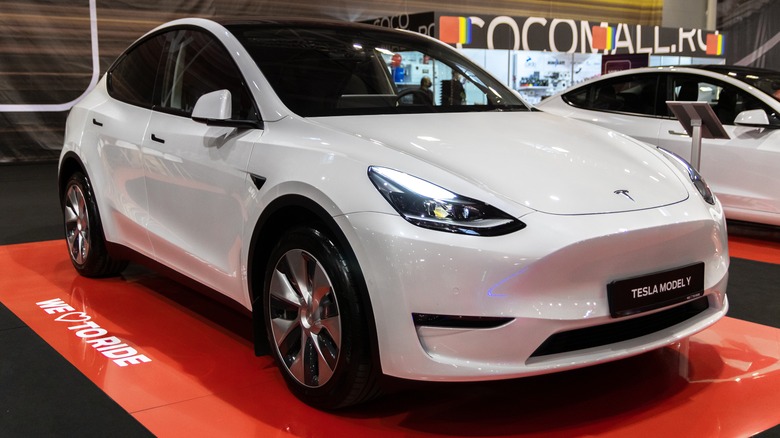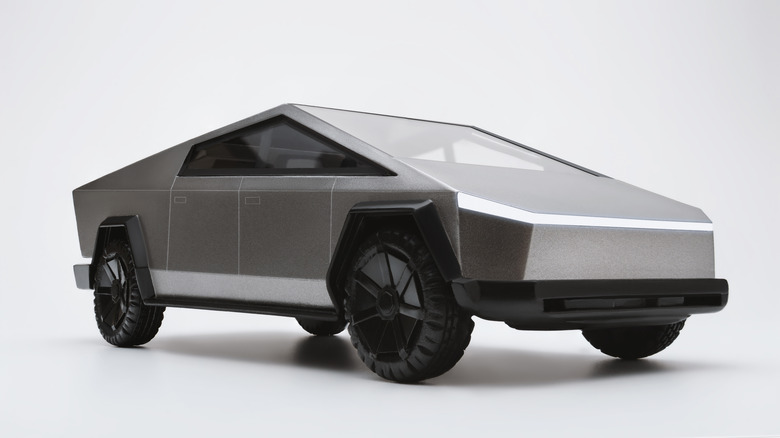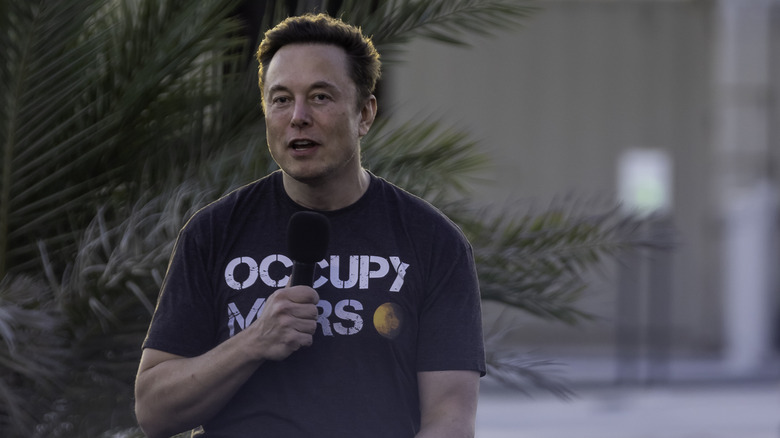Elon Musk Promises Smaller, Cheaper Tesla, But We've Been Burned Before
Tesla is reportedly working on a cheaper electric vehicle that could give millions of people easier access to the zero-emission transportation method. However, like many ideas CEO Elon Musk promotes, and a lot of the things Tesla is currently working on, you probably shouldn't hold your breath. Musk's idea of a $25,000 Tesla was first unveiled in 2020 at the company's annual "Battery Day" event.
If Musk is to be believed, the budget vehicle from the world's most successful electric car manufacturer would be made possible through cheaper and more energy-dense batteries becoming available. Batteries are both vital to how an electric vehicle operates, and a significant expense when constructing or refurbishing one. Replacing the batteries in a Tesla Model Y currently costs over $15,000 — which is just under a third of the price of the most basic Model Y available. While battery tech is getting cheaper, there may still be a long way to go before it hits the levels where a $25,000 Tesla is possible. Even Musk himself said the technology was "at least three years away" back in 2020.
Another way to bring costs down would be to reduce the number of batteries in the vehicle, which would have a tremendous impact on both range and practicality, or skimp on the other components involved. The latter seems to be Musk's preference, with the Tesla CEO believing 370 parts could be cut from the cheaper Tesla — dropping production costs by 69%. While that very exact figure might sound nice on paper, the controversial CEO does have a love of memes and a history of injecting figures like "420" into things like share prices. So while it seems nice, it's fair to take it with a pinch of salt.
Getting a Tesla into production is a long process
Fans of the electric vehicle manufacturer will know that Tesla's plans don't always stick to the schedule. A good example would be the "Cyber Truck," which was announced in 2019, planned for late 2021, had its release pushed back again to late this year, and now, according to Tesla, will finally make it into production by early 2023. Initial delays seem to have been caused by focusing production efforts on the popular Model Y compact SUV. That decision may have been necessary due to supply chain issues, which Musk described as a "nightmare." Tesla isn't the only vehicle producer to have been affected by supply shortages, with automotive giants like Ford and GM closing factories and leaving near-completed but unsellable vehicles sitting in lots. On the whole, U.S. vehicle production has seen a steady decline over the last couple of years, despite surging demand.
Another heavily hyped Tesla that has yet to get a full release is its semi-truck. The truck was announced five years ago, but has yet to be released. According to a tweet from Elon Musk, the long-awaited truck finally started production earlier this month and is expected to be delivered to at least some who pre-ordered it by December this year.
While the details of the Cybertruck's delay are vague, we do know more about what stopped the Tesla Semi going into production. A shortage of batteries seems to have put the brakes on the company's initial attempts to get the truck on the road. In an SEC filing from 2021, the company stated that the delay was: "due to the limited availability of battery cells and global supply chain challenges."
Musk claims the company is still working on a $25k Tesla
Despite the production challenges holding some of its more eagerly anticipated vehicles back, and a recent commitment to putting human-shaped robots in everyone's houses, some of Tesla's efforts are still focused on producing an entry-level EV. As Electreck reported, Musk confirmed the company still had its sights set on producing a more affordable Tesla.
During a call with investors following the release of the company's Q3 2022 earnings report, Musk said: "It's the primary focus of our new vehicle development team, obviously. At this point, we are done with the engineering for Cybertrucks and for Semi. So, it's obviously what we're working on, the next-generation vehicle, which will probably be about half the cost of the 3 and Y platform. It will be smaller, to be clear. Obviously, we're going to take everything we learned from S, X, 3, Y, Cybertruck and Semi into that platform. But we are on a 2-for-1 target. We're trying to get to that 50% number again"
As well as making the vehicle cheaper to produce in terms of raw materials, the smaller size Tesla is apparently aiming for could potentially offset any reduction in range that comes with installing fewer batteries in the vehicle. It also marks a slight change in tactic from the initial concept of the cheaper Tesla, which would feature more advanced batteries and not include parts present in the more expensive options. Still, given shortages and limitations, scaling a vehicle down is more practical than developing and mass producing new, cutting edge, technology. So Tesla's smaller, cheaper, EV may stand a better chance than its other, more ivolved, vehicle projects.
Legislation may make the cheap Tesla even less expensive
As an added bonus, the entry level Tesla of the future could qualify for a significant tax break, potentially making it even more affordable. Changes to EV tax incentives introduced with the Inflation Reduction Act this summer may have created a situation where few, if any, new electric vehicles currently qualify for a full tax credit. However, vehicles made by Tesla didn't qualify with the previous credit, as the manufacturer had already reached the cap on the number of credits vehicles made by a single company could receive. The new system doesn't cap the number of vehicles from a manufacturer that will qualify for the credit, so Tesla buyers can once again claim money back on their purchases.
New EVs qualify for up to $7,500 back, but eligibility depends on where the battery is manufactured and where the materials it was made from are sourced. Tesla has been producing batteries in the US for years, so it is well placed to take advantage of the scheme. Despite the law working in Tesla's favor, not all of its vehicles qualify. Price caps of $55,000 on sedans and $80,000 on other EVs mean the Model S and Model X are ineligible, while the Model Y only qualifies if it is categorized as an SUV. A cheaper Tesla is almost certainly going to be priced at less than $55,000 though, so it shouldn't have any issues.



